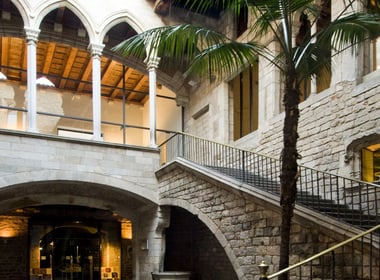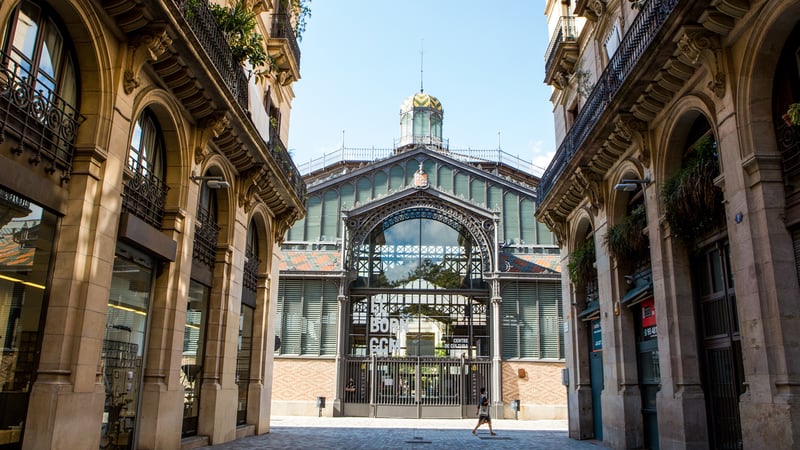İçindekiler
One of the oldest settlements in Barcelona, El Born is a special neighborhood that embodies the spirit and energy of the city. As you wander through the narrow stone streets, you witness how modern life finds a place among the centuries-old buildings. On the one hand, the majestic stance of historic buildings, on the other, the shop windows of chic boutiques, the performances of street artists and the daily life of the locals. Every corner in El Born promises a new surprise. El Born is a special neighborhood in Barcelona, with the smell of fresh bread from the bakeries in the morning, locals gathering and chatting in small squares in the afternoons, and street life coming alive in the evenings.
History of El Born from the Middle Ages to the Present
The history of El Born dates back to the 14th century. This seaside district was once one of the most important commercial centers of Barcelona. A meeting point for artisans, merchants and sailors during the medieval period, El Born takes its name from this lively commercial life. The word “born” means “tournament ground” in Catalan and refers to the square where knightly tournaments were once held.
During the 18th century War of Spanish Succession, the area suffered greatly, and after the fall of Barcelona in 1714, by order of Felipe V, part of the neighborhood was demolished and the castle of Ciutadella was built. This event left a deep mark on the history of El Born.
What to See in El Born
One of the most important features that distinguishes El Born from other neighborhoods is that its historical sites and modern life are very much intertwined. When you walk through this area, you feel like you are walking through an open-air museum.
The Basilica of Santa Maria del Mar is one of the most precious treasures of this neighborhood. Built in the 14th century, the basilica took only 55 years to complete despite the harsh conditions of the time. The interesting thing is that every stone used in its construction was carried on the backs of sailors and merchants. Popularly known as the “Cathedral of the Sea”, this magnificent structure is like the heart of El Born. The tall columns that greet you when you enter, the lights filtering through the colorful stained glass windows and the impressive atmosphere take you to a different time. Especially towards sunset, the interior of the basilica takes on different colors with the light filtering through the stained glass windows and a fascinating view emerges.

Passeig del Born is the pulse of the neighborhood. Historically the site of knight tournaments, this wide avenue has taken on a completely different identity today. In the mornings, locals sip coffee and read their newspapers, at lunchtime tourists flock here to shop, and in the evenings it comes alive with live music performances. The centuries-old buildings lining both sides of the street contrast with the modern cafes, chic restaurants and boutiques on the ground floors. This contrast is one of the details that best reflects the spirit of El Born. Sitting on a bench on Passeig del Born and people-watching is one of the best ways to understand the daily life of the neighborhood.
As you walk towards the Basilica of Santa Maria del Mar at the end of the street, I highly recommend taking a detour into the narrow side streets. There are antique shops, small art galleries and tapas bars serving local delicacies waiting to be explored.
El Born Cultural Center (El Born CCM)
One of El Born’s most impressive attractions, the El Born Centre Cultural is housed in the old iron-constructed market building. Built in 1876, this magnificent structure was one of the city’s most important food markets until 1971. Today, however, it has a completely different mission: Uncovering Barcelona’s lost history.
What was uncovered during excavations during restoration work stunned everyone. Underneath the building, the remains of a neighborhood destroyed in 1714 during the War of Spanish Succession were found. This discovery was so important that while the original plan was to build a library here, the project was completely changed and the building was transformed into a cultural center.

Today, when you visit the center, you can see streets, houses and shops from the 18th century under the glass floor. This 8,000-square-meter archaeological site is like a frozen slice of time. As you walk among the ruins, you can find many clues about the daily lives of the people who lived there: The cellar of a wine shop, a butcher’s shop, even the utensils used in the kitchens of houses, all these details help you understand what Barcelona was like before 1714.
One of the most impressive aspects of the center is the way it uses modern technology to bring history to life. Thanks to interactive screens and three-dimensional modeling, you can imagine what the demolished neighborhood looked like. It also manages to be a living space with regularly changing exhibitions, conferences and cultural events.
Modern El Born: A Meeting Point for Art and Culture
Today, El Born is one of Barcelona’s most vibrant neighborhoods. While preserving its historic fabric, it has been revitalized with modern art galleries, design studios and boutique shops. As you walk through the narrow streets, you may come across a centuries-old church on one side and a modern art gallery on the other.
Food and drinks in El Born
The area is home to restaurants serving the best of Catalan cuisine. From traditional tapas bars to modern cuisine, you’ll find a wide range of options. I would like to suggest a few special places based on my own experience.
Bormuth is one of my favorite tapas bars in El Born. Located on Comercç Street, this place is a favorite meeting point not only for tourists but also for locals.

Cal Pep is one of the legendary restaurants of the region. You have the chance to taste the daily menu prepared by the chef in a limited number of chairs in front of the counter. Specializing in seafood, the place is especially famous for its fresh fish and shrimp plates, reservations are essential.
If you are looking for a more relaxed atmosphere, try Euskal Etxea. Serving the flavors of Basque cuisine, this place draws attention especially with its pintxos (Basque tapas).
El Xampanyet is a historic tapas bar that has been around since 1929. With its blue-and-white tiled walls, shelves full of vintage wine bottles and loud, friendly atmosphere, it’s a Barcelona classic. Their homemade canned food and anchovies (anchovy) platter is a must try.
Daily life in El Born
Despite being a touristic area, El Born retains its local character. The smell of fresh bread from the bakeries in the morning, the melodies of street musicians in the afternoon and the vibrancy of the nightlife turn this place into a vibrant neighborhood.
The surprises you find as you walk through the narrow streets, the antique shops, the children playing in the small squares and the laundry hanging from the balconies are characteristic of the daily life of El Born.

Accommodation in El Born
In the area, there are boutique hotels and apartments in restored historic buildings, where old buildings meet modern comforts, ideal for those who want to experience the spirit of El Born. El Born is a unique neighborhood that combines the history, culture and modern life of Barcelona. Every corner promises a new discovery, every street a new story. Every moment you spend in this neighborhood will give you the true spirit of Barcelona.







